
In the dynamic ecosystem of warehouse management, the role of effective rack labelling stands as a cornerstone. This fundamental element, while seemingly simple, is the guiding star that navigates your staff to the precise product location, ensuring a seamless and efficient workflow.
Without a well-orchestrated rack labelling system, warehouses can quickly spiral into a state of disorder, leading to misplaced products, delayed order fulfilment, and higher operational costs. Moreover, the absence of a proper labelling system can lead to time wastage and errors in inventory management such as overstocking or understocking problems. All in all, these issues cause a ripple effect of inefficiencies throughout the entire supply chain.
Therefore, it is essential to have a well-designed warehouse rack labelling system that can transform your warehouse into a powerhouse of productivity.
In this article, we’ll delve into the nitty-gritty of warehouse rack labelling. We will explore its purpose, discuss the different types of labels, and highlight the benefits of an effective warehouse labelling system. We will then provide practical steps and share best practices to help you architect a top-tier labelling system in your warehouse. Let’s embark on this enlightening journey towards achieving operational excellence!
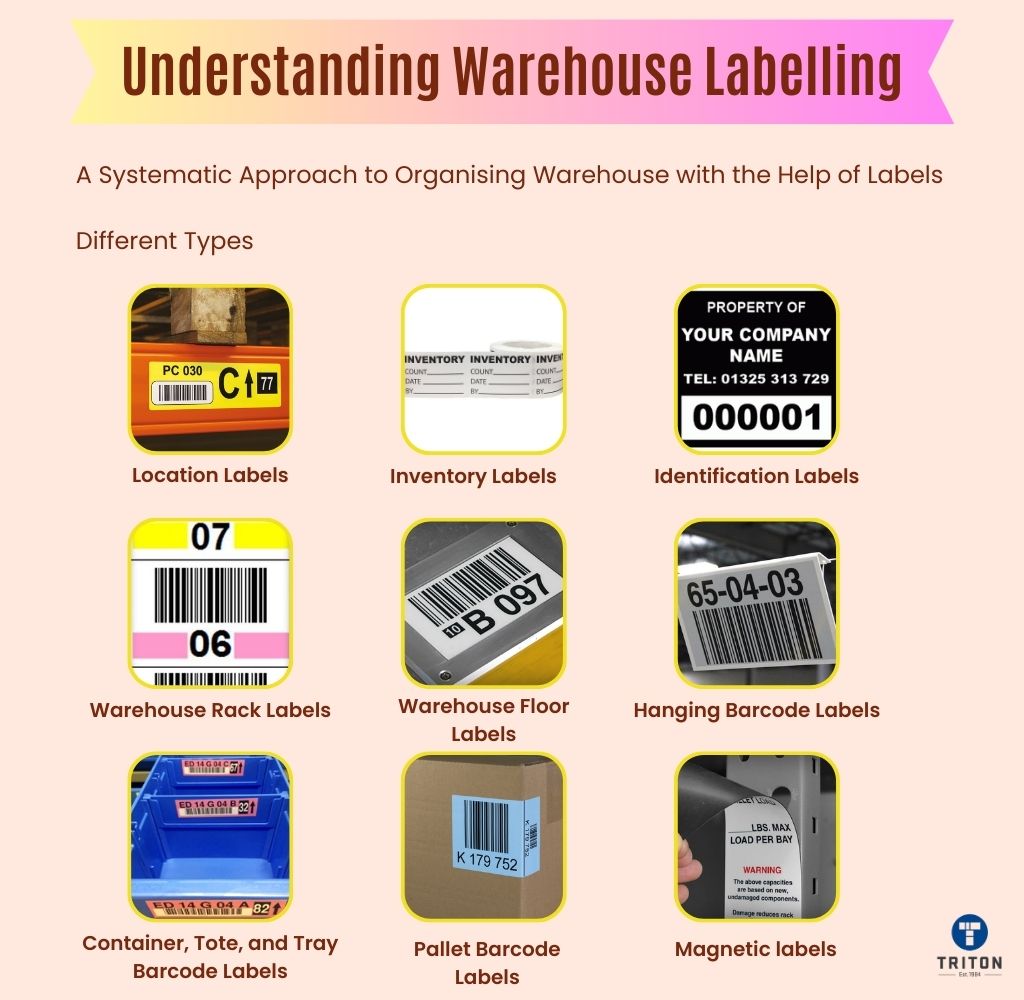
Warehouse labelling is more than just slapping stickers on your racks. It’s a systematic approach to organising your inventory, making it easily identifiable and accessible. At its core, warehouse labelling is about creating a language your warehouse staff and management systems can understand, leading to efficient operations.
There are several types of warehouse labels, each serving a unique purpose:
Implementing a proper labelling system offers numerous benefits, including improved inventory management, increased productivity, and enhanced safety and compliance. By ensuring that every item and location in your warehouse is clearly labelled, you can reduce errors, speed up processes, and make it easier for staff to find what they need.
In the following sections, we will delve deeper into the methods of warehouse rack labelling, steps for effective implementation, and best practices to follow.
When it comes to labelling warehouse racks, there isn’t a one-size-fits-all approach. The method you choose will depend on your warehouse’s specific needs and layout. Here, we will discuss two commonly used racking system:
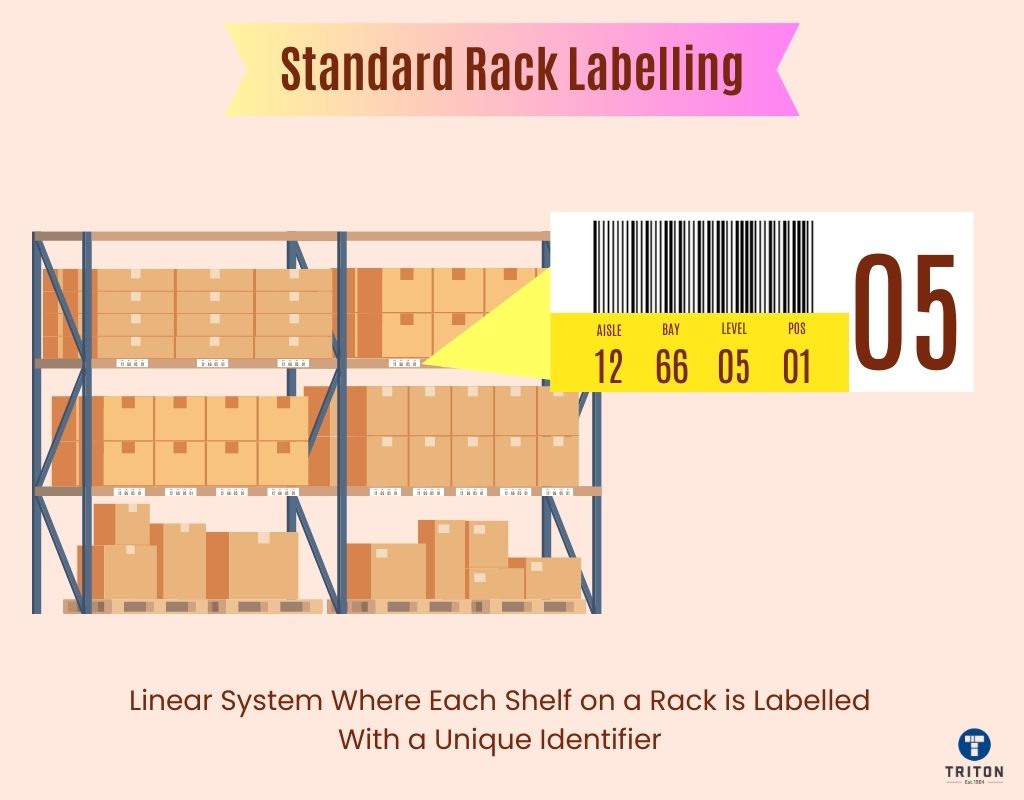
The Standard Rack Labelling method is a linear system where each shelf on a rack is labelled with a unique identifier. This identifier typically includes a combination of aisle, rack, and shelf information, allowing for precise location tracking.
For example, a label might read “A01-R03-S02”, indicating Aisle 1, Rack 3, Shelf 2. This method is straightforward and easy to understand, making it a popular choice for many warehouses. It works exceptionally well in smaller warehouses or those with a simple layout.
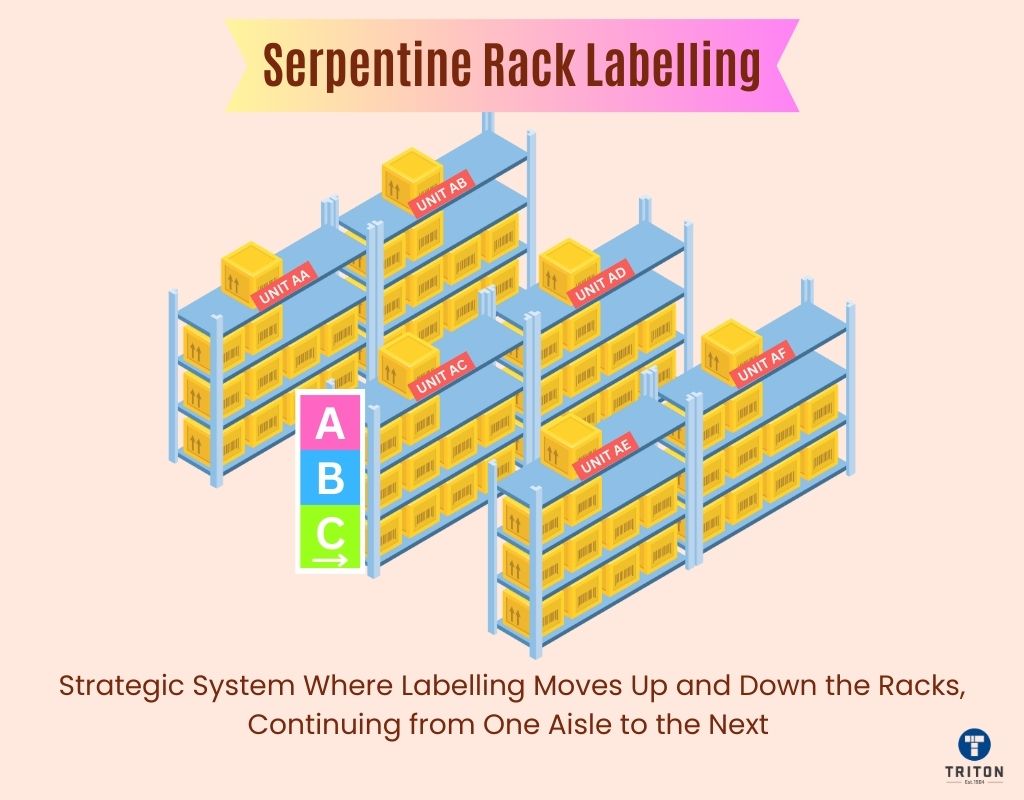
The Serpentine Rack Labelling method, on the other hand, is a bit more complex. In this method, the labelling snakes its way up and down the racks, moving from one aisle to the next.
For instance, the labelling might start at the bottom of Rack 1 in Aisle 1, move up to the top, then down Rack 2 in the same aisle, and so on. This method is particularly useful in warehouses with a large number of aisles and racks, as it allows for a higher number of unique identifiers. However, implementing serpentine rack labelling is more challenging and may require additional training for staff to understand.
Choosing the right labelling method for your warehouse depends on several factors:
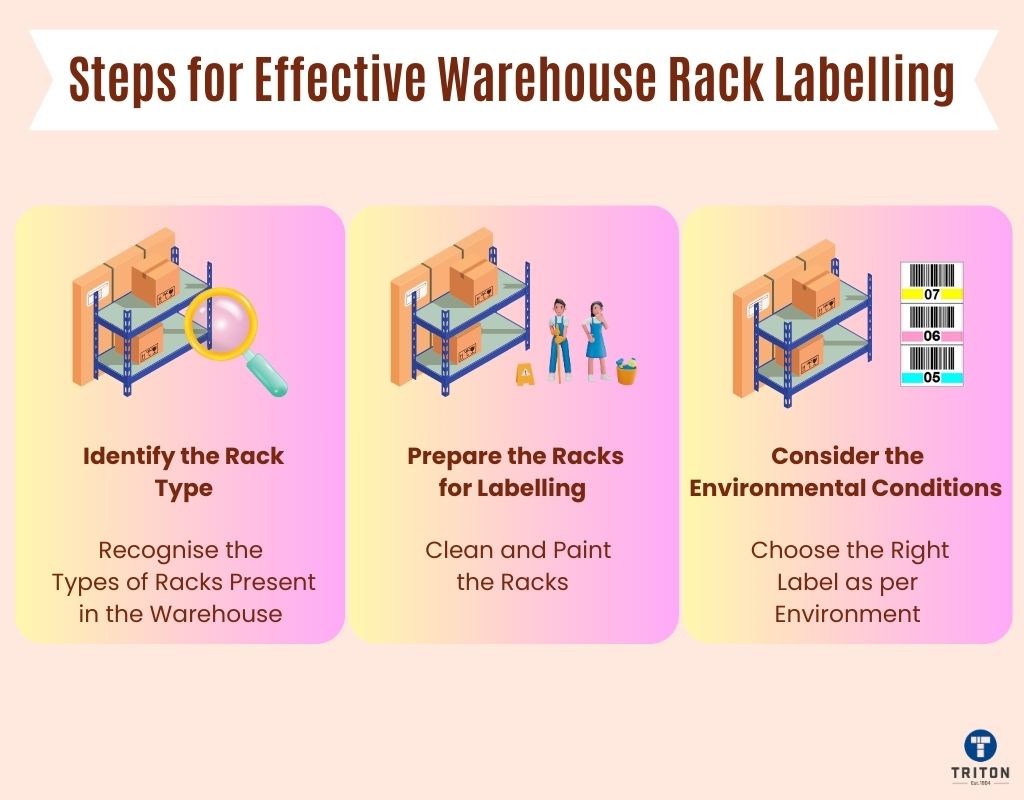
Implementing an effective warehouse rack labelling system may seem like a daunting task, but by breaking it down into manageable steps, you can ensure a smooth and successful process.
Here are the key steps to consider:
The type of racks in your warehouse determines the kind of labels you need.
Pallet racks, typically taller and accessed with forklifts, require larger labels that are readable from a distance. In contrast, smaller bin racks or shelves require smaller labels that are easily read at close range.
Assess the types of racks in your warehouse and select the appropriate labels for each. Also, consider factors such as the distance from which the labels will be read, the lighting conditions, and the equipment used to access the racks.
Before labelling, ensure that your racks are clean and in good condition. Dust, dirt, or damage could interfere with the adhesion of the labels and their visibility.
Clean the racks with mild detergent and warm water to remove any dirt or grease. For stubborn stains, such as oil or sticky residue, a solution of equal parts white vinegar and water can be very effective. Apply the solution to the stain, let it sit for a few minutes, and then scrub with a brush. The acidity of the vinegar helps to break down the oil or residue, making it easier to remove.
Once the racks are clean, let them dry completely.
If the racks are rusty or the paint is chipping, consider repainting them with paint suitable for metal, providing a smooth finish for better label adhesion.
If necessary, apply a protective layer or sealant to the racks to ensure the labels stick properly and last longer.
The conditions in each area of your warehouse dictate the type of labels you need. Cold storage areas require labels that can withstand low temperatures. These labels should have adhesives designed to stick in low temperatures and materials that won’t become brittle or crack in the cold.
On the other hand, outdoor areas or areas exposed to sunlight require UV-resistant labels. These labels should be made from materials that are water-resistant and won’t fade under UV light. They should also have adhesives that can withstand temperature fluctuations and humidity.
Always consider the specific conditions in each area of your warehouse when choosing labels to ensure they will perform well and last as long as possible.
By following these steps, you can ensure a successful implementation of your warehouse rack labelling system. In the next section, we will discuss some best practices to further enhance the effectiveness of your labelling system.
Implementing a warehouse rack labelling system is a significant step towards improving your warehouse operations. However, to maximise its benefits, following some warehouse rack labelling best practices is important.
Here are some key points to consider:
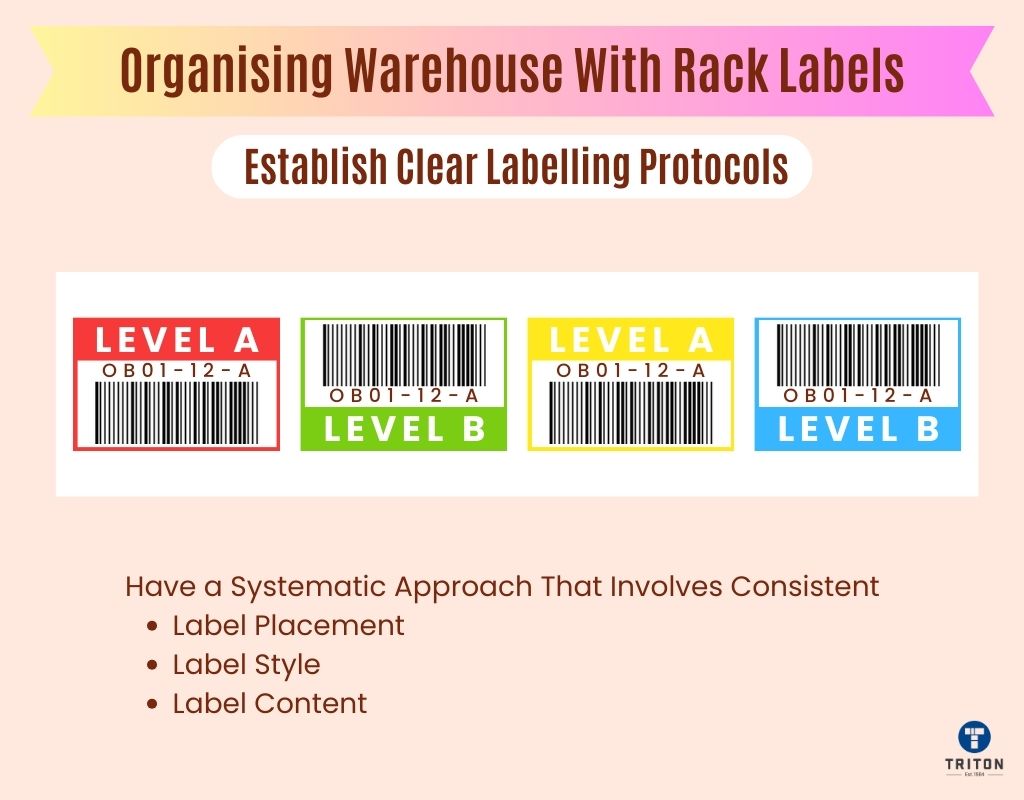
The foundation of an organised warehouse lies in the establishment of clear labelling protocols. This involves a systematic approach to labelling that includes consistent placement, style, and content of labels.
For instance, maintaining uniformity in label placement, such as at eye level, and using the same font and colour scheme throughout the warehouse can facilitate quick item location. The content of the labels should be concise and informative, providing all the necessary details without being overly complicated.
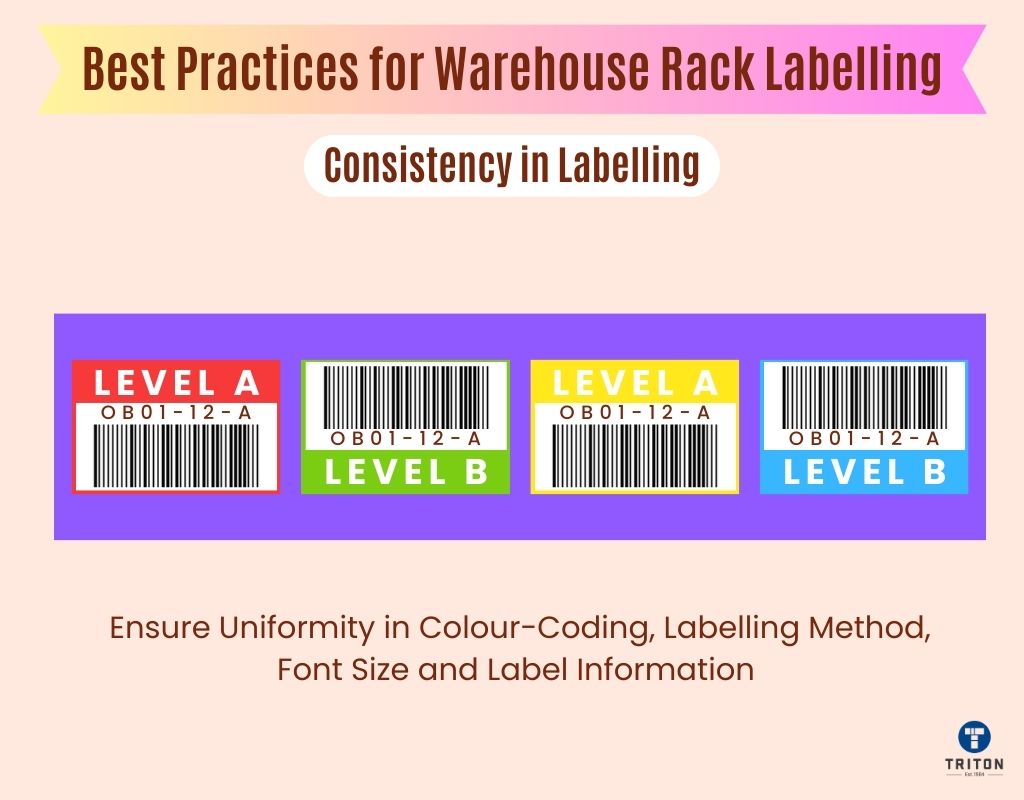
Consistency in labelling is not just a recommendation but a vital necessity for maintaining a smooth workflow in your warehouse.
For instance, if you’ve adopted a colour-coding system, it’s crucial to maintain this system throughout the warehouse. Suppose you’ve assigned the colour blue to electronics and red to hazardous materials. In that case, this coding should be uniformly applied, enabling staff to instantly recognise the type of product just by looking at the colour of the label. This consistency extends beyond colour-coding, encompassing aspects like the labelling method, font size, and the information on the labels.
Maintaining such uniformity significantly reduces confusion and potential errors, paving the way for an efficient and error-free warehouse operation.
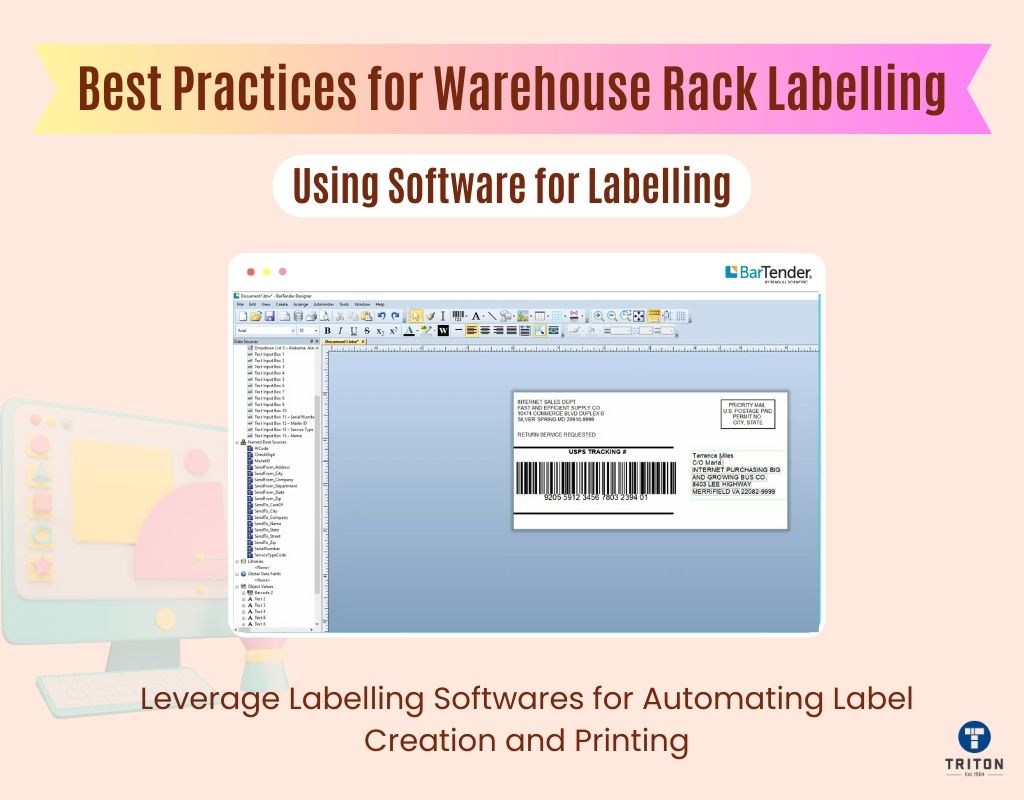
In the digital age, leveraging software for labelling can significantly streamline your warehouse operations.
Labelling software can automate the creation and printing of labels, ensuring consistency and accuracy. It can also integrate with your existing warehouse management system, allowing for real-time updates as your inventory changes.
One such software is BarTender, a leading solution for designing, printing, and automating the production of labels, barcodes, RFID tags, and more. BarTender can adapt to any business size and need, providing a scalable solution that grows with your business. It’s a worthy investment that can revolutionise your labelling process.
At Triton, we’re proud to offer Seagull Scientific’s BarTender Software, a trusted solution for all your labelling needs. We understand that every organisation is unique, which is why we provide all four BarTender editions: Starter Edition for small teams, Professional Edition for more complex labelling requirements, Automation Edition for those preferring an automated process, and Enterprise Edition for large organisations.
We’re also excited to offer BarTender Cloud, the latest innovation for managing label printing and design operations on the go.
At Triton, our commitment is to provide the best software options for our customers. We’re confident that BarTender Software will not only meet but exceed your expectations.
So why wait? Experience the best software solutions for your business today. Contact us now via the live chat widget, or fill out a form here to get started.
Refer to our Understanding BarTender Software to learn more about this amazing label design and printing software.
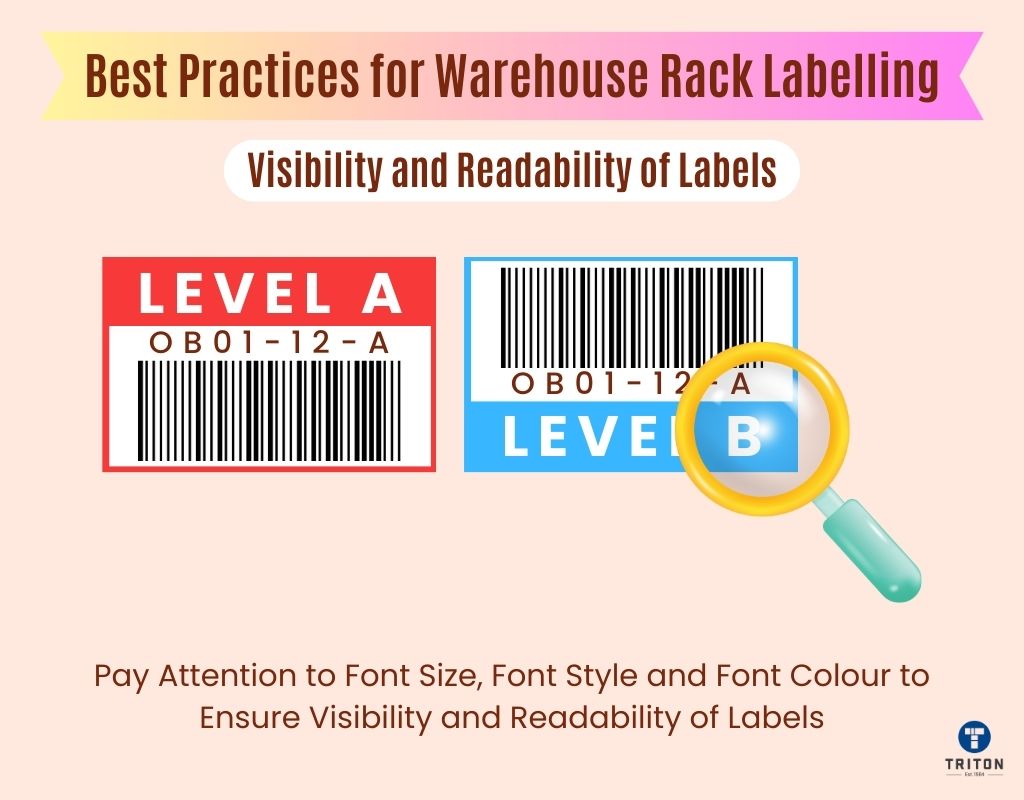
Labels serve as the guiding compass in a warehouse, directing staff to the correct location swiftly and accurately. Therefore, their visibility and readability from a reasonable distance are paramount.
The labels should be of a size that stands out from afar, with text that is clear and easy to read. They should be strategically placed in well-lit areas and at an optimal height for easy viewing. Using contrasting colours can further enhance visibility, making the labels instantly noticeable.
We will delve deeper into making labels visible and easy to read in the next section of the article.
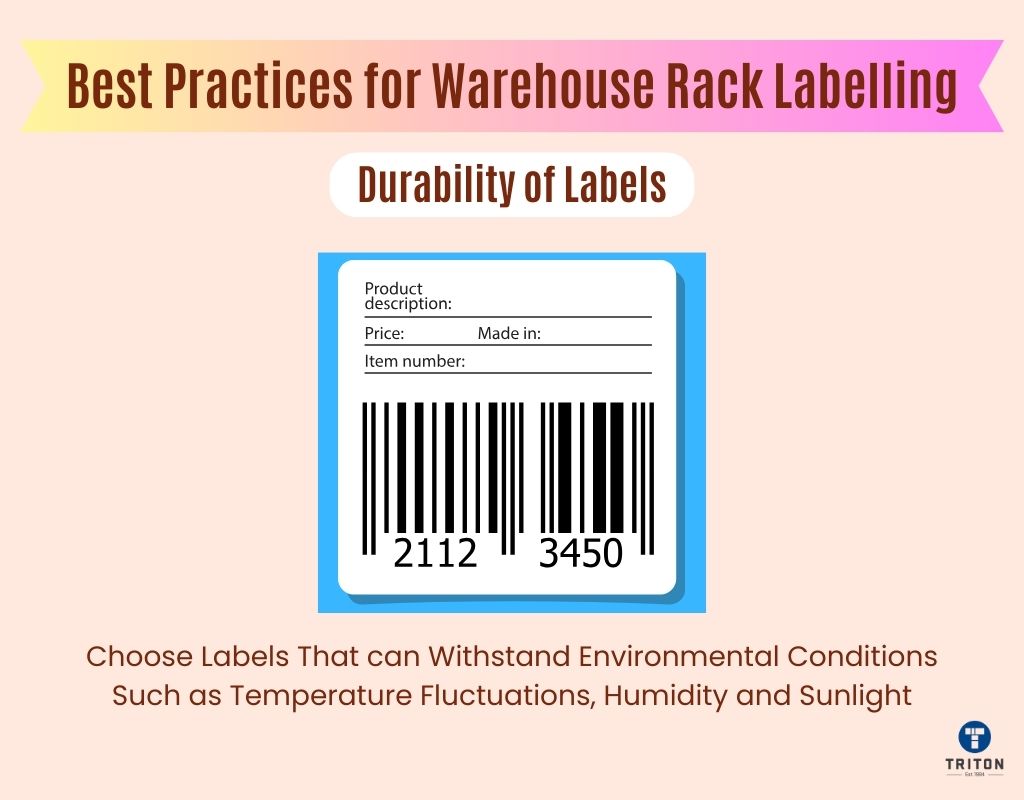
The durability of your labels is crucial for maintaining an effective labelling system. Labels need to withstand the conditions of your warehouse, which can vary greatly depending on the location and type of goods stored.
In general, labels should be able to withstand environmental conditions such as temperature fluctuations, humidity and sunlight. Moreover, they should be resistant to wear and tear from handling and should remain adhered to the racks even in high-traffic areas.
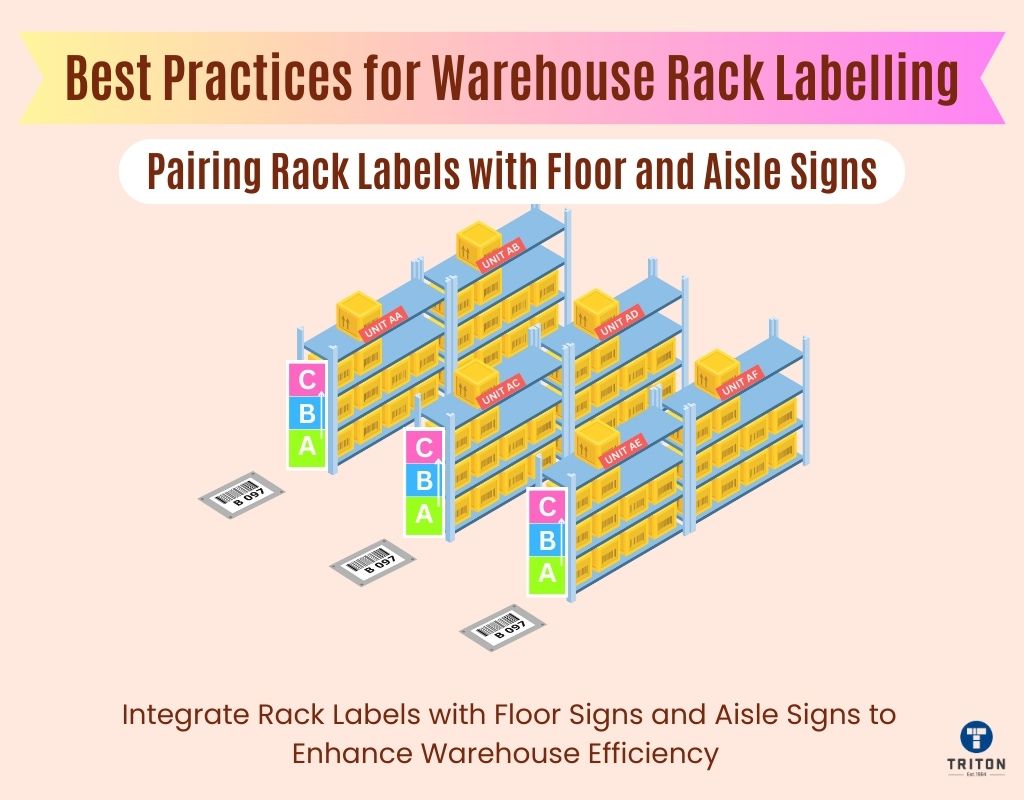
It’s a good practice to pair rack labels with floor and aisle signs to enhance navigability.
Floor signs are markers placed on the warehouse floor to provide directional information, identify aisles, or designate specific areas for certain activities. Aisle signs, on the other hand, are placed at the end of each aisle to help workers identify the correct aisle quickly.
For example, if a rack label reads “A01-R03-S02”, you could have matching floor signs at the beginning of Aisle 1, and additional aisle signs pointing towards Rack 3 and Shelf 2. This multi-level guidance system not only simplifies the process of locating items but also significantly reduces the time it takes for staff to do so, especially in large warehouses.
Integrating rack labels, label shelves, floor signs, and aisle signs creates a comprehensive and efficient navigation system that boosts productivity and reduces errors.
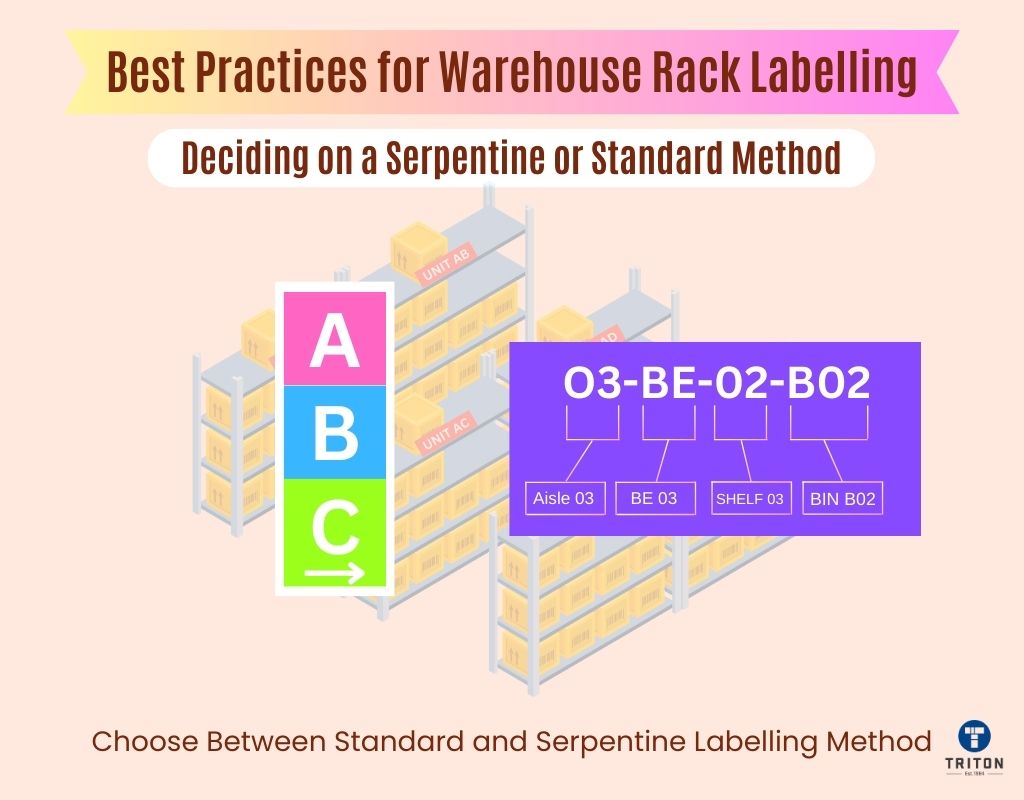
As discussed earlier, the choice between a standard or serpentine labelling method will depend on your specific warehouse needs. Consider factors like the size of your warehouse, the complexity of your operations, and the training level of your staff when making this decision.
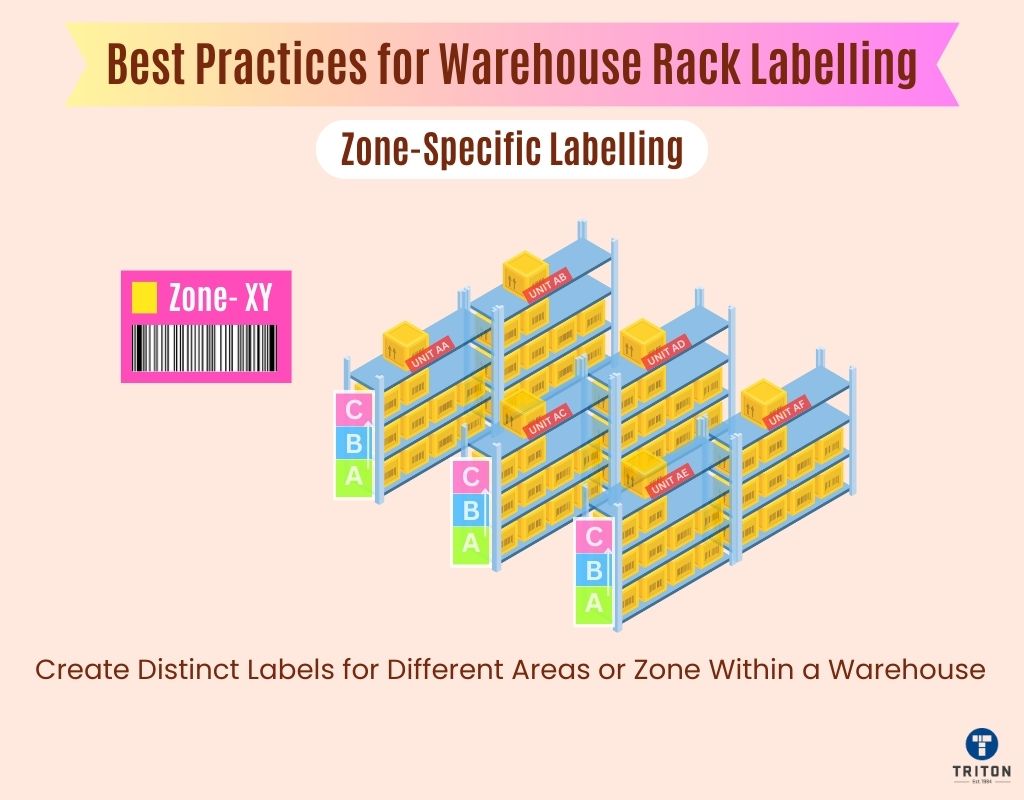
Zone-specific labelling, also known as zone-based labelling, simply means creating distinct labels for different areas or zones within a warehouse. In this labelling strategy, specific labels or colour codes are assigned to various zones in the warehouse to make it easier for staff to identify the correct location for each item. This practice is particularly beneficial in large warehouses that have different sections dedicated to different types of products or handling requirements.
For instance, one might have a ‘Cold Storage’ zone for perishable items and a ‘Bulk Storage’ zone for large items.
Each zone’s label would use a specific colour or symbol to differentiate it from others, making it easy for employees to identify the correct area for each item quickly and ensuring that special handling requirements, such as for fragile items, are readily visible.
This approach serves as a valuable tool for optimising warehouse operations. When staff can easily discern different zones, it streamlines the process of locating and retrieving items, reducing errors and saving time. Additionally, zone-specific labelling can aid in better inventory management, enabling efficient stock replenishment and order fulfilment.
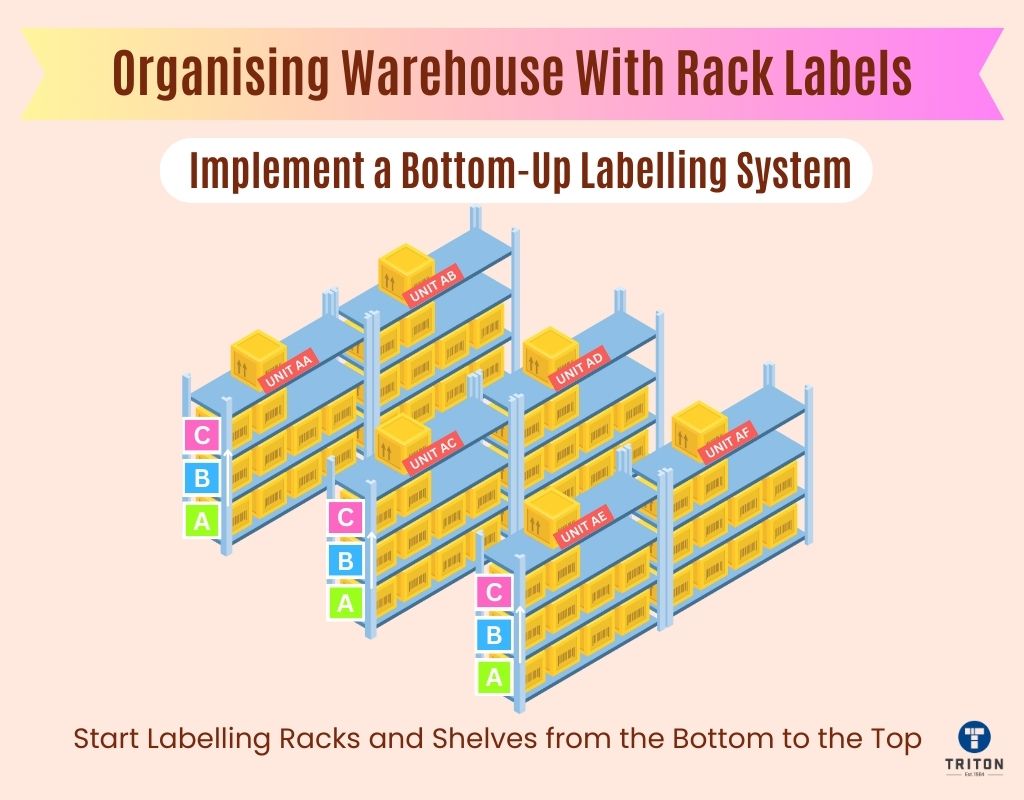
A bottom-up labelling system, where labels are placed on racks from the bottom up, is an effective strategy for warehouse organisation.
This system not only allows for quick and easy identification of products but also minimises the risk of label damage, as they are less likely to be ripped off or displaced. Moreover, this system can save time and money by eliminating the need for workers to constantly stop and look up product information.
Importantly, a bottom-up labelling system also allows for easy expansion of shelving space or relocation to a larger warehouse without the need to re-label every rack.
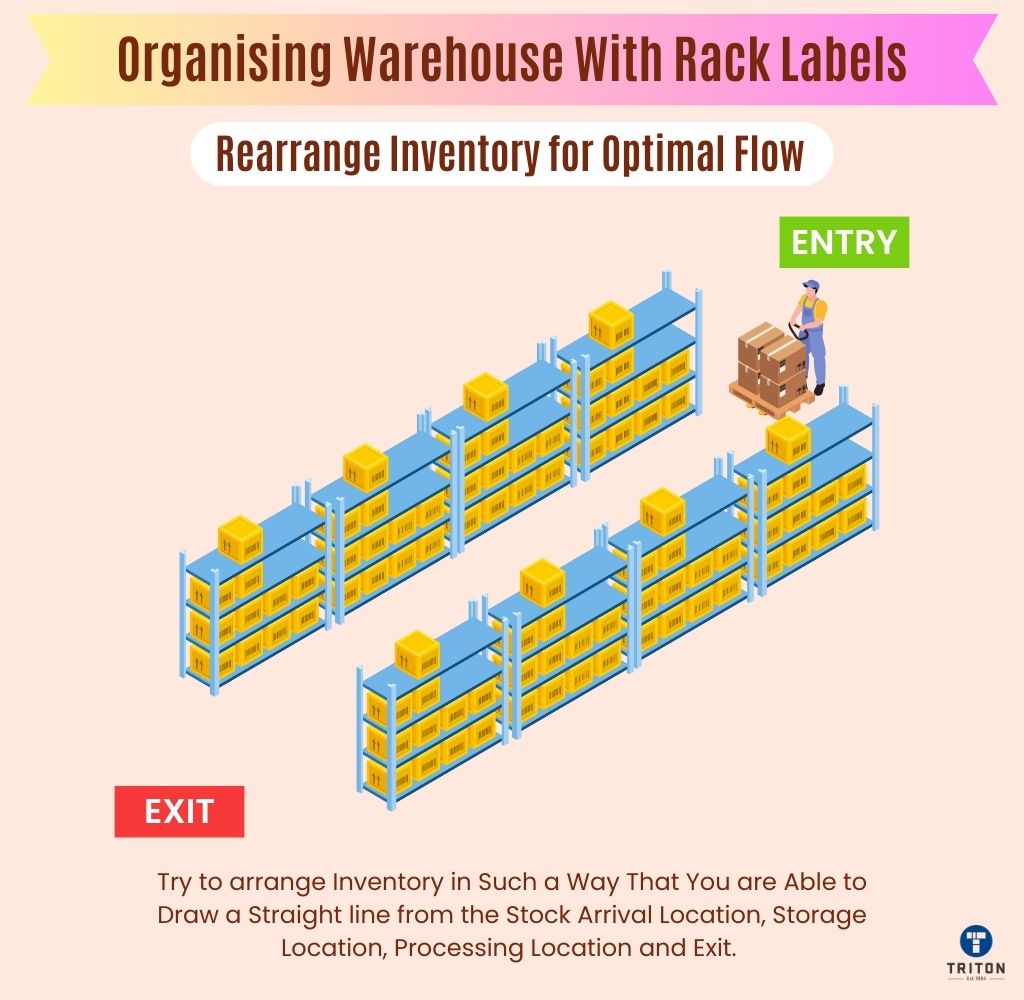
The arrangement of your inventory should facilitate the most efficient movement of items through your warehouse. Ideally, you should be able to draw a straight line from the location where your stock arrives, to where it is stored and processed, to where it eventually leaves the warehouse. This involves eliminating unnecessary steps, saving space, and moving your inventory more quickly.
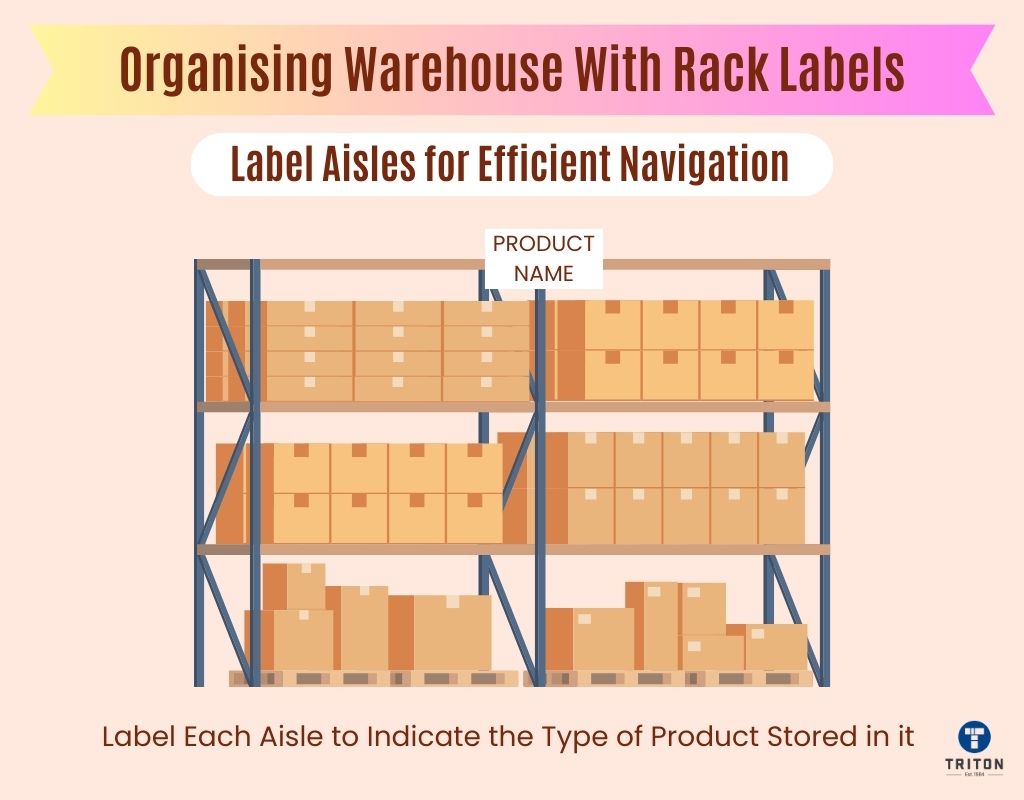
In a busy warehouse, having a systematic and efficient method for labelling aisles is paramount. This can be achieved through colour-coded labels or labels that indicate the type of product contained in each aisle. This allows pickers to immediately know whether or not the product they are looking for is in an aisle, saving valuable time in the process.
Moreover, it’s beneficial to encourage employee foot traffic to travel in a single direction to increase efficiency. This means designing your warehouse layout in such a way that workers move in one direction along the aisles, like a one-way traffic system. This can help prevent congestion, reduce the risk of accidents, and improve the overall flow of operations. You could also use floor markings or signs to indicate the direction of traffic in each aisle.
Additionally, consider using hanging signs for large warehouses. These signs hang from the ceiling and can be seen from a distance, making it easier for workers to navigate large spaces. They can be colour-coded or numbered to match the rack labels, providing a cohesive and efficient navigation system.
By implementing these strategies, you can effectively organise your warehouse with rack labels, leading to increased efficiency and productivity.
The effectiveness of a warehouse rack labelling system largely depends on the visibility and readability of the labels. Here are some tips to ensure your labels are easy to see and read:
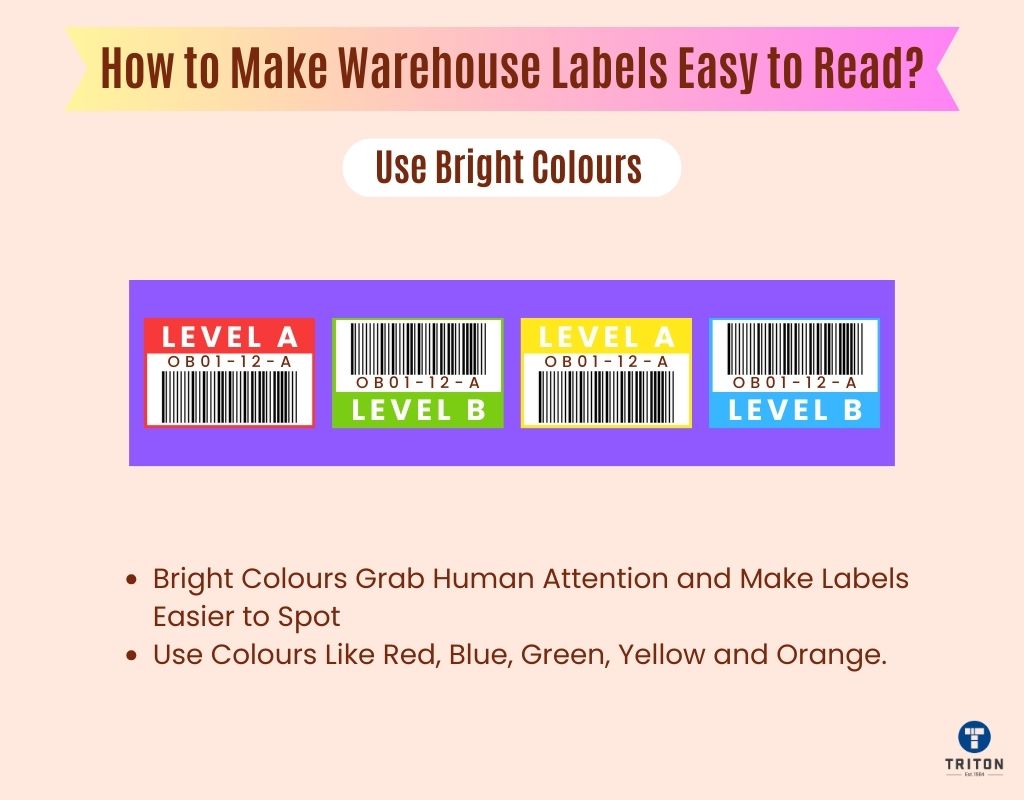
Colour plays a pivotal role in our perception and cognition. It’s no surprise that bright, clear colours can significantly enhance the effectiveness of your warehouse rack labels.
Bright colours stand out, making labels easier for workers to spot from a distance. Moreover, our brain registers bright contrasting colours in a flash, which helps reduce put-and-pick errors and improves operational efficiencies.
Here are some colours you might consider for your warehouse labels:
Avoid using colours that are too similar to each other, as they can be easily confused.
For instance, using both light blue and dark blue for different categories might lead to mix-ups. Similarly, using colours that are too pale or too close to the colour of the rack or shelf might make the labels hard to see.
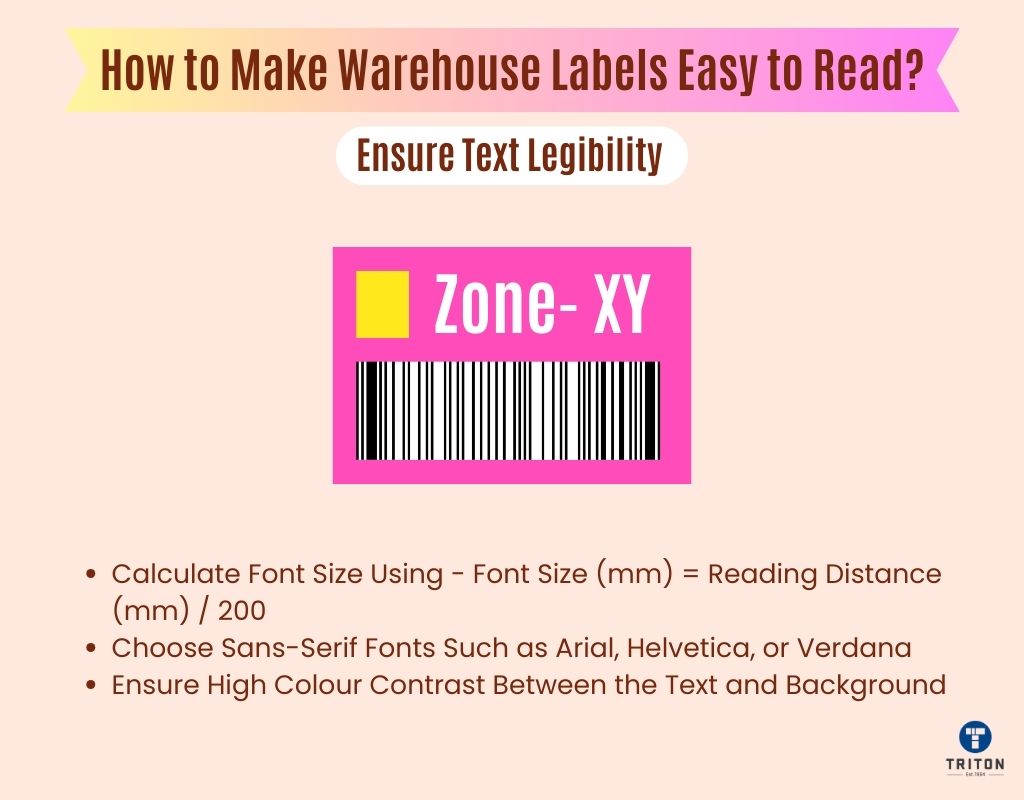
The legibility of the text on your labels is crucial. If your staff can’t read the labels quickly and accurately, it can lead to errors and inefficiencies. The size of the text should be large enough to be easily read from a reasonable distance.
According to health.gov, for most adults, 16 pixels (12-point) or larger text is easily readable. However, for warehouse labels, which need to be read from a distance, larger text sizes are necessary.
The recommended font size can be calculated using the formula –
Font Size (mm) = Reading Distance (mm) / 200
Let’s put the formula – Font Size (mm) = Reading Distance (mm) / 200 – into practice with some examples tailored for warehouse settings:
These examples demonstrate how to use this simple formula to determine the appropriate font size for your warehouse labels based on the reading distance.
The font style plays a significant role in the readability of your labels.
It’s advisable to opt for simple, sans-serif fonts such as Arial, Helvetica, or Verdana, which are known for their clear, straightforward design and excellent readability even from a distance. These fonts have clean lines without extra embellishments, making them easy to read quickly.
On the other hand, it’s best to steer clear of overly decorative or script fonts like Monotype Corsiva, Brush Script, or Papyrus. While these fonts might look attractive, they can be challenging to read quickly, especially from a distance.
Similarly, condensed fonts such as Impact or Haettenschweiler, while space-saving, also compromise readability due to their narrow, compact design.
Remember, the primary purpose of your labels is to convey information quickly and accurately, so prioritising readability over aesthetic considerations is key.
The colour of the text and its background also plays a role in legibility. High contrast between the text and background improves readability.
For instance, black text on a white background or white text on a dark background are good choices.
Keeping your location label names succinct and straightforward is crucial for efficiency. Long or complicated label names can be difficult to read and remember, slowing down your staff and increasing the chance of errors.
Instead, use simple, clear names that accurately describe the location. For instance, a label might read “A01-R03-S02”, indicating Aisle 1, Rack 3, Shelf 2. This label is short, easy to read, and clearly indicates the location.
The key is to keep the labelling system intuitive and easy to understand so that even a new employee can quickly get the hang of it.
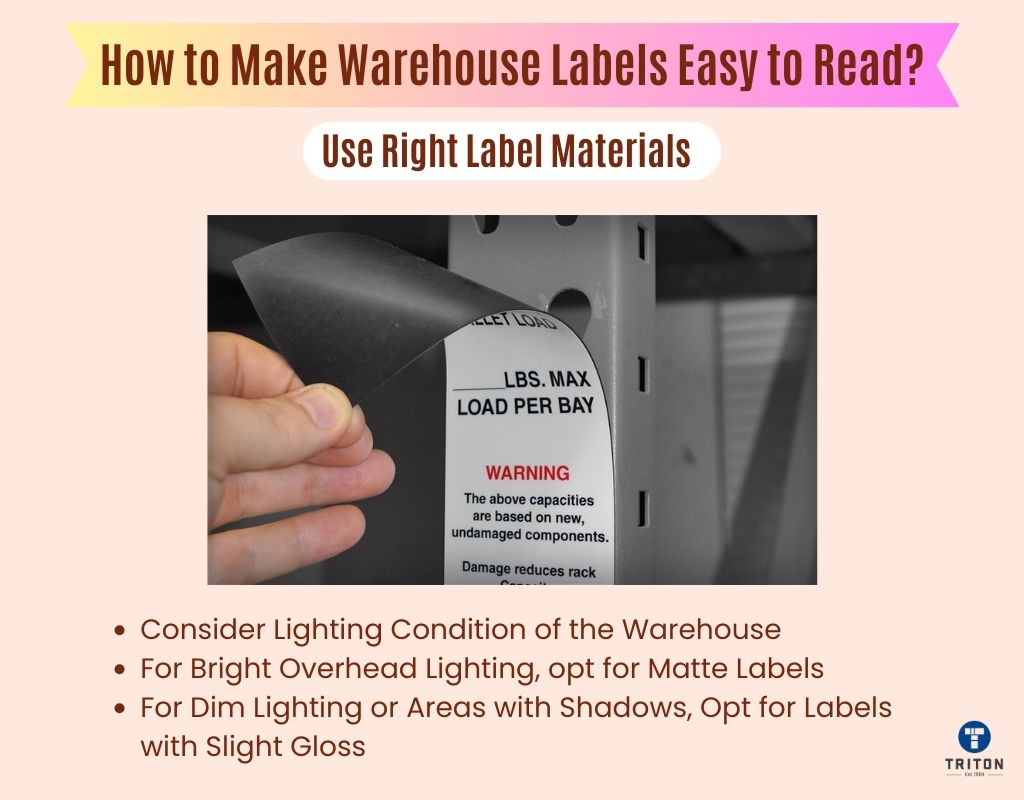
The choice of label material significantly impacts the visibility and readability of your labels.
For example, labels with a glossy finish, while aesthetically pleasing, can reflect light, making them difficult to read under certain lighting conditions. On the other hand, matte labels, with their non-reflective surface, can offer better readability under bright lighting.
The lighting conditions in your warehouse should be a key consideration when choosing your label materials.
If your warehouse is equipped with bright overhead lighting, opting for matte labels could be a strategic choice to minimise glare and maximise readability.
In contrast, if your warehouse has dim lighting or areas with shadows, consider labels with a slight gloss or sheen. These labels can catch and reflect even low light, making them more visible in less illuminated areas. Moreover, you can also consider using labels with high-contrast colour schemes to enhance visibility in low-light conditions.
However, it’s important to strike a balance to ensure the labels are not too reflective, as this can also hinder readability.
Remember, the ultimate goal is to ensure that your labels are easily readable in all areas of your warehouse. Therefore, it’s worth spending time assessing the lighting conditions in different areas and choosing the label materials and colours accordingly to optimise visibility and readability.
The information on your warehouse labels should be concise yet comprehensive enough to facilitate efficient operations.
Typically, this includes a unique identifier for the location (such as aisle, rack, and shelf numbers) and may also include barcodes or QR codes for easy scanning. If the label is for a specific product, it should include the product name, SKU number, and any other relevant details like weight or size.
Remember, the goal is to provide all the necessary information for accurate picking and inventory management without overwhelming the reader with too much detail.
When printing warehouse labels, it’s important to ensure high-quality output for clear readability. Here are some best practices:
We highly recommend using thermal printers such as desktop label printers, industrial label printers, direct thermal printers, thermal transfer printers and barcode label printers for printing warehouse labels.
The best way to label racks depends on your warehouse’s specific needs and layout. However, some general best practices include using clear, legible text, bright colours for visibility, durable materials that can withstand warehouse conditions, keeping location label names succinct, and involving a label manufacturer from the start.
Aisles in a warehouse can be labelled using signs or labels placed at the end of each aisle. These labels should include a unique identifier for the aisle, which can be a number or letter. The labels should be large and clear enough to be easily seen from a distance.
Data racks can be labelled in a similar way to warehouse racks. Each rack and each shelf within the rack should have a unique identifier. This can be a combination of numbers and letters that indicate the rack number and the shelf number.
The type of labels you should use for your warehouse racks depends on the conditions in your warehouse. If your warehouse is particularly cold, you’ll need labels that can withstand low temperatures. If your warehouse is humid, you’ll need labels that are resistant to moisture.
Always choose high-quality, durable materials that can withstand the conditions in your warehouse and will last for a long time without fading or peeling.
The frequency of updating your warehouse rack labels depends on the changes in your inventory and warehouse layout. If you frequently add new products or change the layout of your warehouse, you may need to update your labels more often.
However, in general, it’s a good idea to review your labelling system at least once a year to ensure it’s still effective and accurate.
Yes, software like BarTender can be used to design and print your warehouse rack labels. This can make the process of creating labels more efficient and ensure consistency in your labelling system.
Visit our BarTender Software homepage for more details about this incredible label printing and design software.
If a label becomes damaged or unreadable, it should be replaced as soon as possible to avoid confusion or errors. It’s a good idea to keep a stock of spare labels on hand for this purpose.
Training your staff to understand the labelling system can involve a combination of written instructions, hands-on training, and regular reminders or refresher courses. It’s important to ensure that all staff members understand the system and know how to use it effectively.
Ensuring the visibility and readability of your warehouse labels over time requires a careful selection of materials, colours, and text sizes.
Choose high-quality, durable materials that can withstand the conditions in your warehouse, such as temperature fluctuations, humidity, and exposure to chemicals or UV light.
Opt for bright, contrasting colours and clear, legible fonts that can be easily read from a distance.
Regular inspections and maintenance of the labels, including cleaning and replacement if necessary, will also help keep them in optimal condition.
As we navigate the intricate maze of warehouse management, the significance of a robust rack labelling system emerges as a beacon of efficiency and order. Warehouse rack labelling is the silent guide that navigates your staff through the labyrinth of aisles and racks, leading them to the exact location of the products they need. It’s the key to unlocking a world of efficiency and productivity, transforming your warehouse into a synchronised powerhouse.
Throughout this article on warehouse rack labelling best practices, we’ve explored the purpose and types of best warehouse labels, delved into the methods of rack labelling, viewed some warehouse rack labelling ideas and provided a step-by-step guide to implementing an effective labelling system. We’ve also shared best practices and practical tips to make your labels visible and easy to read.
So, whether you’re setting up a new warehouse or looking to improve your existing operations, take notice of the power of effective rack labelling. Use the insights and tips shared in this article to architect a top-tier labelling system in your warehouse.
Thanks for reading!
Melbourne
Brisbane
Phone 1300 558 438
Live Chat – Widget below
Melbourne
Brisbane
Phone 1300 558 438
Live Chat – Widget below